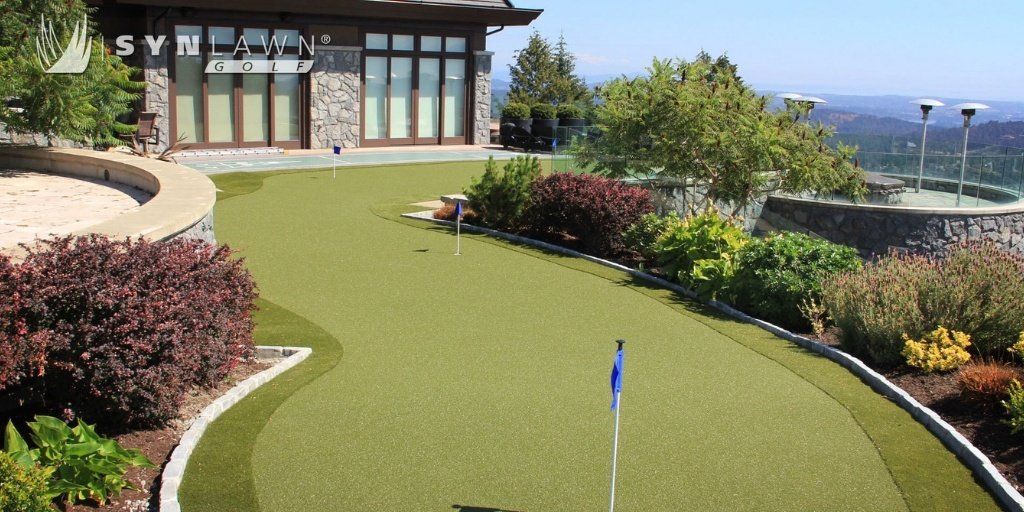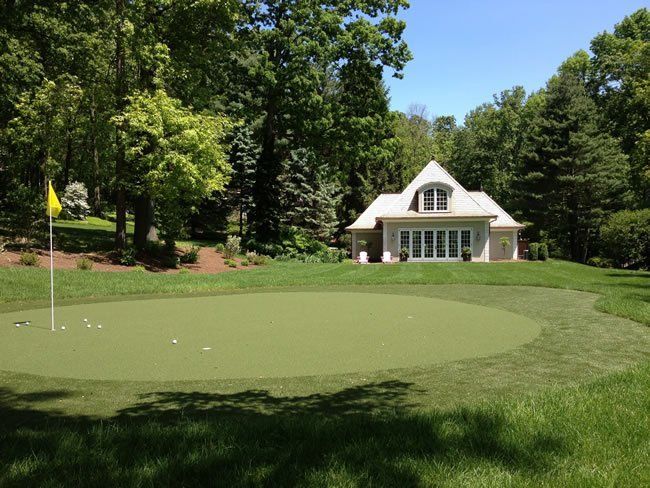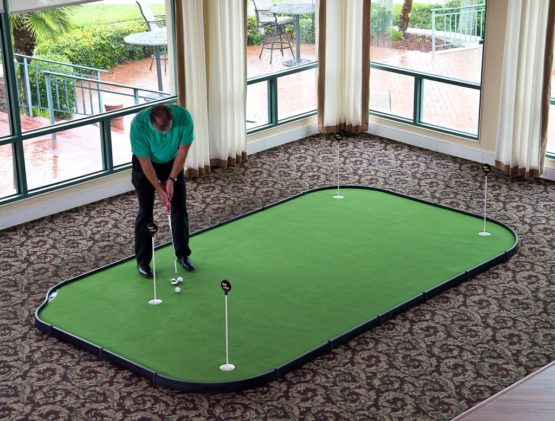
Whether it’s always been a vision for your dream home or you have trouble finding the time to squeeze putting practice into your busy schedule, a backyard putting green can help your landscape and game shine.
There are several ways to add a putting surface to your property. In this guide, we’ll show some of the options available and what to expect when choosing your green (no mowing required).
We will cover:
- DIY putting greens
- Standalone options available for purchase
- Professionally installed greens
DIY Backyard Putting Greens
The DIY method is doable if you are handy and like having control over the result, both in design and budget. DIY doesn’t have to be spendy, but this option will be the most labor-intensive. If you’re up to the challenge: rent some equipment, call a few buddies with the promise of their favorite beverage, and get ready for a couple of days of landscaping.

The process looks a little like this:
- Pick an area of your yard and dig out your green (about 6-8” deep, especially important in cold weather areas) plus additional width for fringe and rough.
- Fill with heavy road gravel as a base for water drainage and top with fine gravel or road dust.
- Level the surface with a plate compactor as you go.
- Cover the area with landscape fabric to prevent weeds from popping up.
- Using a post hole digger, make holes and place the cups.
- Lay out the turf and secure the edges and seams with pegs or staples.
- Add fringe or rough for short game practice and to mesh with remaining yard.
- Cut out the holes from the turf with a utility knife.
- Add infill to change green speed and help protect and support turf from wear and exposure.
This video from the Canadian company Bella Turf is extremely comprehensive:
For a quicker idea of the process, check out this 14-hour project using the Tour Links system:
Some companies offer kits with one less step by providing pre-cut base layers and turf (like in the previous video) that piece together like a puzzle. Groups like Pro Putt Systems and Tour Links have different size kits and custom orders that allow you to have a smooth putting surface with a lot less work.
The cost will depend mostly on the size of the area you are converting. And most of that cost will come in the form of green turf. Bulk turf costs around $5/sq. Ft, especially for high-quality material. With the additional cost of cups, pins, turf pegs, fringe material, base layer, a top layer, compactor rental, and a 24-pack, you’re probably looking at anywhere from $6-12/sq. Ft.
If you decide to use one of the UltraBaseSystems like Tour Links, you will likely add on another few bucks per foot but will save some of that in your base layer.
Although this option is the most labor-intensive, it is also the most rewarding. All of the decisions and work will be yours to make while saving you some green for putting lessons. At the end of the weekend, you can sit back and enjoy your work.
Purchasing Standalone Backyard Putting Greens
There are plenty of accessibility issues you may have with the DIY method. Maybe you have less of a yard and more of a patch, or your HOA won’t let you dig up your lawn for the benefit of your game--you still have other options!
Standalone backyard putting greens are a great compromise without breaking the bank.

This is more of your “above ground” option and allows you to place your putting green in your yard, on the patio, or even stick it in a section of your garden if you don’t want to kill the lawn. Besides that, you aren’t tied down to one spot like the in-ground versions.
Once again Tour Links and Pro Putt Systems give you the option to assemble various sizes without the need for tools. With these systems, you get a sturdy base, premium surface material, and cups already installed and cut out. You can also purchase accessories to add break to your surface, making it infinitely customizable.
Here is an example of how much less work is required for one of these systems:
Other companies, like SYNLawn, use a foam base instead of molded plastic. Options like this may be better if you need to move it often due to limited space.
Prices range from $779 to nearly $4000, or about $15-20/sq. Ft. It might be a little more of an investment, but you can take it with you if you happen to move!
Professional Installation
The final option to consider is having professionals install a putting green for you. Backyard putting greens are so common now that many landscaping companies have dedicated synthetic turf teams.
Professional installation will most likely be the most expensive option, but you can guarantee it will be done correctly and with an expert touch to incorporate the surrounding area. Here is an example of an installation by a professional team using SYNLawn:
First, you will need to find someone to do the job. A quick Google search of your area should turn up several companies with experience in installation. If that doesn’t get the results you’re looking for, you can contact turf companies like Tour Greens or Southwest Greens to get a list of authorized dealers in your area.
Next, contractors will work with you to evaluate the area and design the green, giving you extra options for short game areas and even bunkers. Everything after that will be left to their capable hands and the depth of your wallet.
And now with your new knowledge from reading the DIY section, you can follow along as the pros transform your backyard.
Quotes usually start around $15-25/sq. ft. Of course the larger the area and the more features you pick, the higher the price tag. Additional labor costs come into play when contractors have to do more work to a foundation or have difficulty accessing an area. All of these other costs should be discussed at the beginning of your project and agreed upon before starting.
Wrapping It Up
If you are interested in having a backyard putting green with synthetic turf, there are three paths you can take. Going the DIY route might save you some money, but it is only recommended for the "handier" golfers out there. If you want a more premium experience done correctly, then you can always hire a local contractor to pay for it, but it will cost significantly more.
Lastly, there are several options for an out-of-the-box system that require very little labor.
Best of luck on your project! If you want to practice effectively on your backyard putting green be sure to check out our complete guide to putting.
We care about the protection of your data Read our Privacy Policy